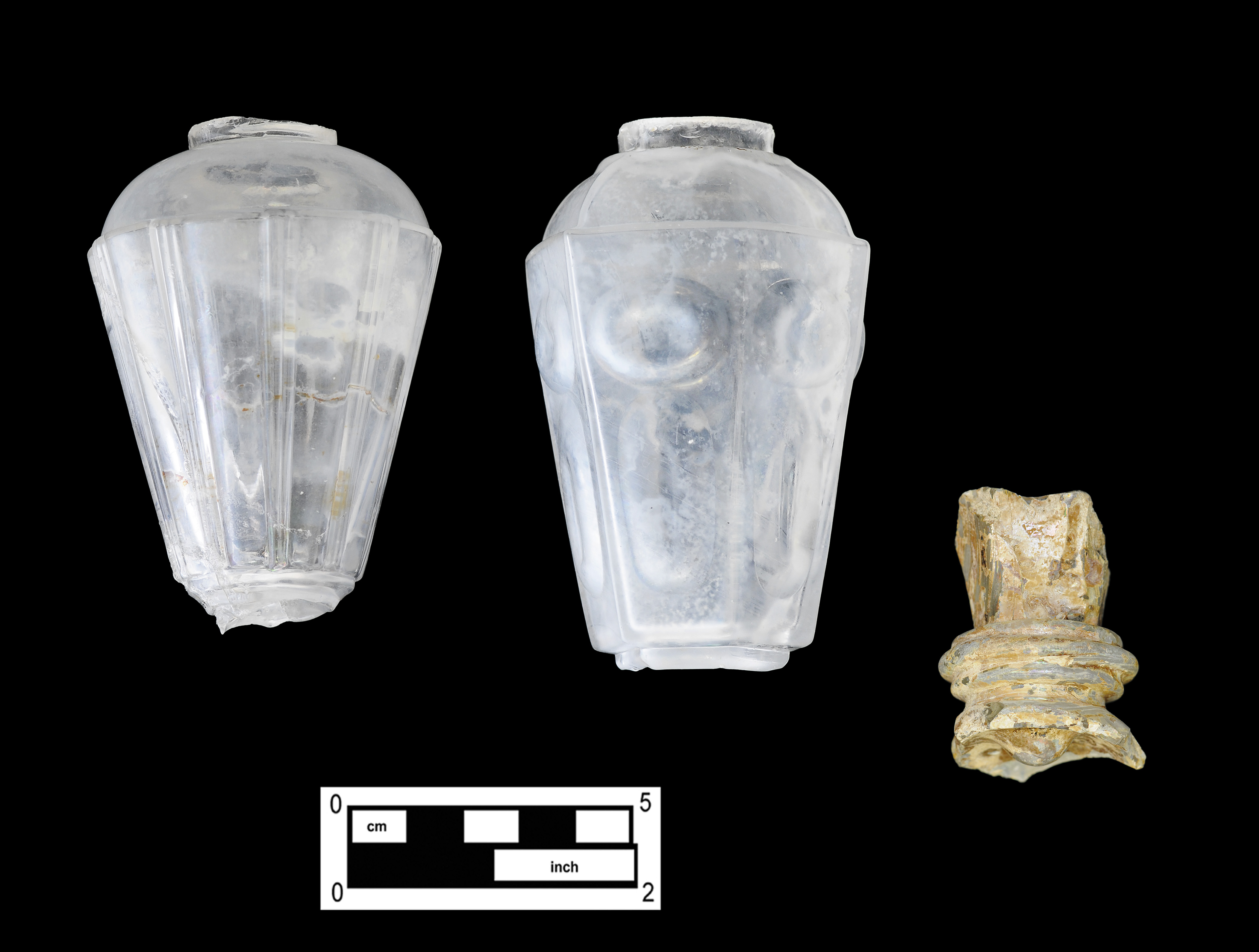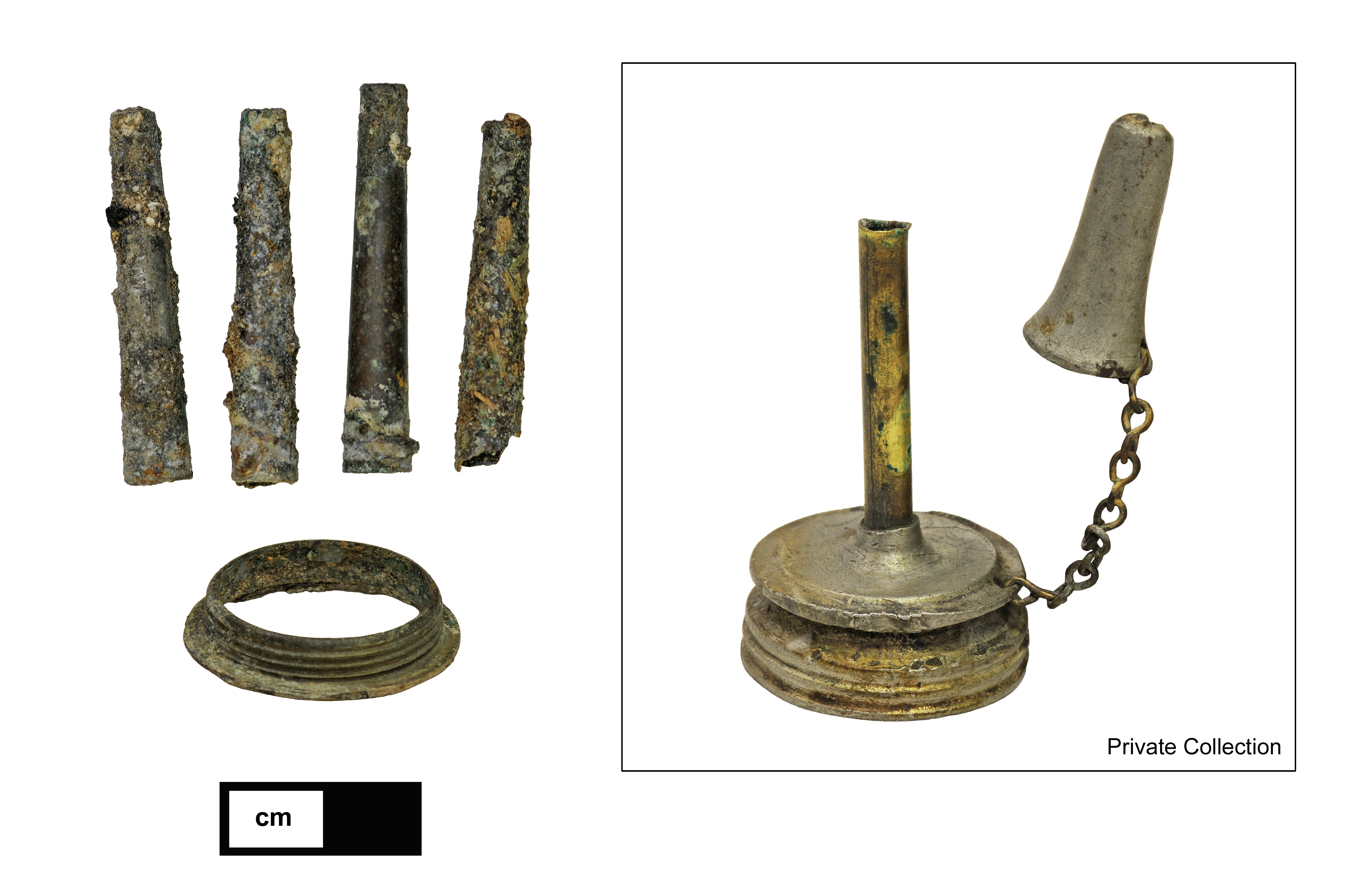Although few in number, the eight artifacts related to lighting provide information on the specific type of illumination used. In addition, two of the artifacts appear to have been produced in Boston at the short lived American Glass Company (1847–1857) and represent a patented manufacturing technique.

Glass Lamps
Portions of three different colorless glass lamps were recovered from this feature. Two of the examples are nearly complete lead glass fonts—the upper portion of the lamp that holds the fuel. Both fonts closely resemble published examples that are attributed to the American Glass Company based on comparison with artifacts excavated in 1997 from the glassworks site in South Boston. 1
One font features a blown-molded pattern with vertical ribbed panels formed in a three part mold (G-0864). The recovered font appears to match an example in the Levine Collection made from green glass. Joan E. Kaiser identified the blown molded pattern of nine broad ribs, each flanked by three narrow ribs, as McKearin and McKearin GI-12. 2
The other font was also mold blown in a pattern known as circle and ellipse, or leaf and concave (G-0962). 3 Kaiser illustrated a blue glass example from the Levine Collection that matches fragments found during the archaeological excavations at the South Boston site.
Patrick F. Slane and John Golding of East Cambridge, Massachusetts, patented the manufacturing technique used to create these two fonts. Their application for “Making glass lamps” received Patent number 3,892, dated January 23, 1845, antedated July 23, 1844. 4
Kaiser provides a brief description of the patented process:
Slane and Golding patented a mechanical device by which a metal sectional mold in which a lamp font was blown was positioned, supported, and perfectly centered above a previously pressed, still-hot, glass lamp base that had been removed from its mold and placed on the device’s heated metal platform. The font mold was adjusted vertically so that the standard of the pressed base projected slightly into the open bottom of the font mold. Glass blown into the font mold extruded through the open bottom, surrounding and adhering to the upper 1/8 inch of the pressed standard. 5
Another piece of evidence that suggests these two lamp fonts originated in Boston appeared in a newspaper notice published in Philadelphia. On March 17, 1855, the Daily Pennsylvanian advertised for sale “1000 packages of Boston Flint Glassware direct from the American Glass Company consisting of entirely fresh made goods and many new designs…” 6 Listed among the variety of vessel forms offered were “lamps for oil and fluid.”
A third lamp was identified by a single piece representing the mid-section (Cat # 8.56.59). Although only a small portion of the font survives, it appears to be free-blown in a globe shape. The base was pressed in a mold with seven vertical flutes on the exterior, along with a series of narrow vertical ribs shaped by the plunger on the interior surface. Of particular interest is the method used for connecting the blown font and pressed base. On this example, the glassblower joined the top and bottom of the lamp by adding a wafer or disk of glass called a merise. This method was commonly used to connect the two lamp parts prior to the introduction of the Slane and Golding patent.
The presence of these three lamps provides the opportunity to compare the hand-joined lamp to the two patented lamps connected inside of the mold. While we do not know how the three lamps broke, the two patent lamp fonts each broke away from the base at the point of attachment, suggesting a potential manufacturing flaw.

Camphene Burner Tubes
Four thin metal tubes were recovered from this shaft feature. Each copper alloy tube measures about 1.5 inches in length and tapers slightly at one end (Cat # 8.47.19, 8.51.14, 8.51.15). These fragments are wick tubes or holders from a lamp fueled by burning fluid or camphene. Burning fluids were commonly used for home lighting from the 1840s until the early 1860s, and required special burners to maintain a distance between the flame and the fuel.
The most distinctive feature is the shape of the wick tubes. They extend about an inch and a half above the base plate and not at all below it, so as to keep the flame away from the font. The tubes are narrower than those of whale-oil burners, and have a distinct taper from bottom to top. 7
Camphene burners were available, featuring from one to five tubes projecting from the top of the burners. It is not clear if the recovered wick tubes originated from a single multi-tube style burner or from several burners. “Volatile camphene needed a strong draft to burn effectively and the wick tubes were angled away from each other and tapered to improve wick security.” 8 Burners for camphene had small metal caps usually attached to the edge of the burners via small chains. When the lamp was not in use, a cap was placed over each wick tube to prevent the fluid from evaporating. No caps or connecting chains were recovered from this shaft feature.
Metal Collar
A flanged copper alloy ring, with threading on the exterior, may have been part of the metal collar used to secure the burner onto a glass lamp (Cat # 8.51.18). The flange measures approximately 1.2 inches in diameter, with a height of 0.24 inches.
References
- Joan E. Kaiser, The Glass Industry in South Boston (Lebanon, NH: University Press of New England, 2009), 93, 95. ↩
- Kaiser, Glass Industry in South Boston, 93. ↩
- Kaiser, Glass Industry in South Boston, 95. ↩
- Kaiser, Glass Industry in South Boston, 76. ↩
- Kaiser, Glass Industry in South Boston, 77. ↩
- “Boston Flint Glassware” advertisement, Daily Pennsylvanian, March 17, 1855, p. 3, Genealogy Bank, subscription database accessed August 2016, http://www.genealogybank.com. ↩
- Loris S. Russell, A Heritage of Light (Toronto: University of Toronto Press, 1968), 97. ↩
- Lowell Innes, Pittsburgh Glass 1797–1891 (Boston, MA: Houghton Mifflin Company, 1976), 312. ↩